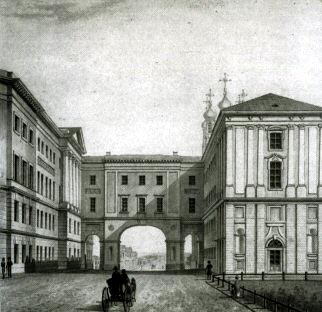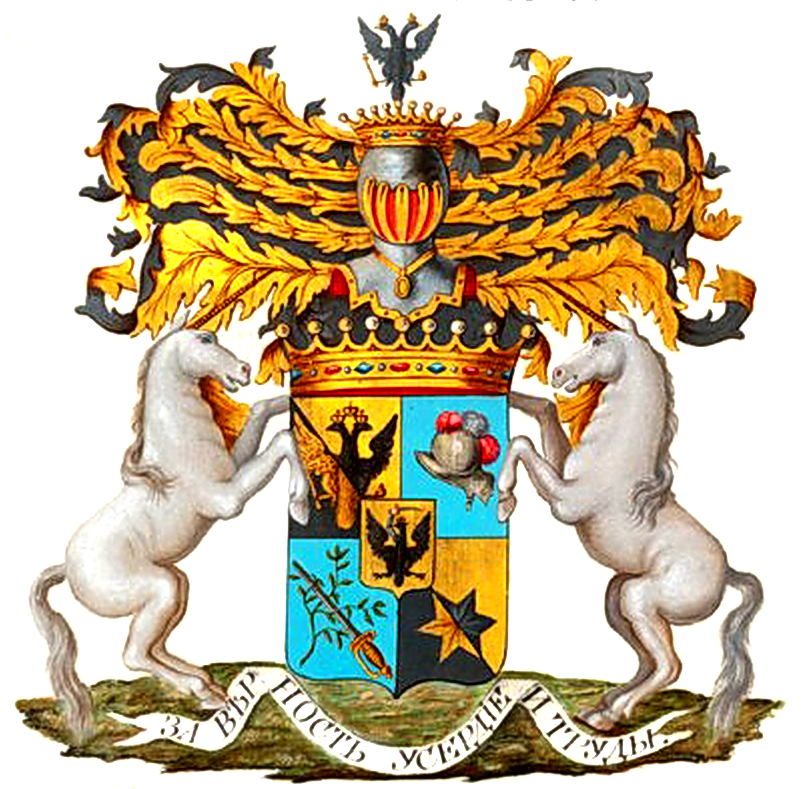|
Saltykov-Shchedrin
Mikhail Yevgrafovich Saltykov-Shchedrin ( rus, Михаи́л Евгра́фович Салтыко́в-Щедри́н, p=mʲɪxɐˈil jɪvˈɡrafəvʲɪtɕ səltɨˈkof ɕːɪˈdrʲin; – ), born Mikhail Yevgrafovich Saltykov and known during his lifetime by the pen name Nikolai Shchedrin ( rus, Николай Щедрин), was a major Russian writer and satire, satirist of the 19th century. He spent most of his life working as a civil servant in various capacities. After the death of poet Nikolay Nekrasov, he acted as editor of a Russian literary magazine ''Otechestvenniye Zapiski'' until the Tsarist autocracy, Tsarist government banned it in 1884. In his works Saltykov mastered both stark realism and satirical grotesque merged with fantasy. His most famous works, the family chronicle novel ''The Golovlyov Family'' (1880) and the political novel ''The History of a Town'' (1870) became important works of 19th-century fiction, and Saltykov is regarded as a Russian literature#G ... [...More Info...] [...Related Items...] OR: [Wikipedia] [Google] [Baidu] |
The Golovlyov Family
''The Golovlyov Family'' (russian: Господа Головлёвы, translit=Gospoda Golovlyovy; also translated as ''The Golovlevs'' or ''A Family of Noblemen: The Gentlemen Golovliov'') is a novel by Mikhail Saltykov-Shchedrin, written in the course of five years, first published in 1880, and generally regarded as the author's ''magnum opus''. ''The Golovlyov Family'' is regarded as a classic of Russian literature. According to D. S. Mirsky, it is "the gloomiest book in all Russian literature", and "this one book" places the author "in the very front line of Russian realistic novelists and secures him a permanent place among the national classics". Background The principal characters of the novel are based on the members of Saltykov's family. Saltykov's mother is closely portrayed in Arina Petrovna, while Porphyry has many features of Saltykov's older brother Dmitry. N. Belogolovy, Saltykov's friend and doctor, described the family as "savage and ill-tempered" and relations ... [...More Info...] [...Related Items...] OR: [Wikipedia] [Google] [Baidu] |
The History Of A Town
''The History of a Town'' ( pre-reform Russian: ; post-reform rus, История одного города, Istoriya odnogo goroda) is a 1870 novel by Mikhail Saltykov-Shchedrin. The plot presents the history of the town of Glupov (can be translated Foolsville), a grotesque microcosm of the Russian Empire. Written in the Era of the Great Reforms in the 19th century, it was neglected for a long time and rediscovered only in the 20th century. It is regarded by critics as the author's masterpiece and sometimes even compared to Gabriel García Márquez's '' One Hundred Years of Solitude''. Background In the 1867-1868 Saltykov-Shchedrin stopped working upon the cycle of satirical sketches ''The Pompadours'' and started upon the novel, seeing it a kind of a spin-off for the cycle. In January 1869 the two first chapters appeared in the ''Otechestvennye Zapiski'' magazine. A pause followed and lasted till the end of the year: the author wrote and published several satirical fairytales ( ... [...More Info...] [...Related Items...] OR: [Wikipedia] [Google] [Baidu] |
Otechestvenniye Zapiski
''Otechestvennye Zapiski'' ( rus, Отечественные записки, p=ɐˈtʲetɕɪstvʲɪnːɨjɪ zɐˈpʲiskʲɪ, variously translated as "Annals of the Fatherland", "Patriotic Notes", "Notes of the Fatherland", etc.) was a Russian literary magazine published in Saint Petersburg on a monthly basis between 1818 and 1884. The journal served liberal-minded readers known as the ''intelligentsia''. Such major novels as Ivan Goncharov's '' Oblomov'' (1859), Fyodor Dostoyevsky's '' The Double'' (1846) and '' The Adolescent'' (1875) and Mikhail Saltykov-Shchedrin's ''The Golovlyov Family'' (1880) made their first appearance in ''Otechestvennye Zapiski''. Founded by Pavel Svinyin in 1818, the journal was published irregularly until 1820. It was closed down in 1830 but resurfaced several years later, with Andrey Krayevsky as its publisher. The renovated magazine regularly published articles by Vissarion Belinsky and Alexander Herzen, catering to well-educated liberals. Other nota ... [...More Info...] [...Related Items...] OR: [Wikipedia] [Google] [Baidu] |
Nikolay Nekrasov
Nikolay Alexeyevich Nekrasov ( rus, Никола́й Алексе́евич Некра́сов, p=nʲɪkɐˈlaj ɐlʲɪkˈsʲejɪvʲɪtɕ nʲɪˈkrasəf, a=Ru-Nikolay_Alexeyevich_Nekrasov.ogg, – ) was a Russian poet, writer, critic and publisher, whose deeply compassionate poems about the Russian peasantry made him a hero of liberal and radical circles in the Russian intelligentsia of the mid-nineteenth century, particularly as represented by Vissarion Belinsky and Nikolay Chernyshevsky. He is credited with introducing into Russian poetry ternary meters and the technique of dramatic monologue (''On the Road'', 1845). As the editor of several literary journals, notably '' Sovremennik'', Nekrasov was also singularly successful and influential. Biography Early years Nikolay Alexeyevich Nekrasov was born in Nemyriv (now in Vinnytsia Oblast, Ukraine), in the Bratslavsky Uyezd of Podolia Governorate. His father Alexey Sergeyevich Nekrasov (1788-1862) was a descendant from Russia ... [...More Info...] [...Related Items...] OR: [Wikipedia] [Google] [Baidu] |
Russian Literature
Russian literature refers to the literature of Russia and its émigrés and to Russian-language literature. The roots of Russian literature can be traced to the Middle Ages, when epics and chronicles in Old East Slavic were composed. By the Age of Enlightenment, literature had grown in importance, and from the early 1830s, Russian literature underwent an astounding golden age in poetry, prose and drama. Romanticism permitted a flowering of poetic talent: Vasily Zhukovsky and later his protégé Alexander Pushkin came to the fore. Prose was flourishing as well. Mikhail Lermontov was one of the most important poets and novelists. The first great Russian novelist was Nikolai Gogol. Then came Ivan Turgenev, who mastered both short stories and novels. Fyodor Dostoevsky and Leo Tolstoy soon became internationally renowned. Other important figures of Russian realism were Ivan Goncharov, Mikhail Saltykov-Shchedrin and Nikolai Leskov. In the second half of the century Anton Chekho ... [...More Info...] [...Related Items...] OR: [Wikipedia] [Google] [Baidu] |
1826 In Literature
This article contains information about the literary events and publications of 1826. Events *Early months – Aftermath of the Decembrist revolt in the Russian Empire. Michael Lunin, though not involved in the Decembrist conspiracy, is arrested and deported to Siberia, which allows him to begin his work as a philosopher. Adam Mickiewicz, deported from Congress Poland for his involvement with Filaret Association, is moved from Taurida Governorate to Moscow. Here, he publishes his ''Sonety krymskie'' (The Crimean Sonnets). Later in the year, he befriends Russian writers, including Yevgeny Baratynsky, Mikhail Pogodin, Alexander Pushkin, and the '' Lyubomudry''. Pushkin, himself returning from political exile, still writes poems discreetly honoring the Decembrists. They include ''Stansy'' (Stanzas), as well as odes to Nikolay Mordvinov and Ivan Pushchin. *c. January – Japanese poet Kobayashi Issa, pained by his recent divorce, enters his final creative period with '' hokku'' ex ... [...More Info...] [...Related Items...] OR: [Wikipedia] [Google] [Baidu] |
Ivan Kramskoi
Ivan Nikolaevich Kramskoi (russian: Ива́н Никола́евич Крамско́й; June 8 (O.S. May 27), 1837, Ostrogozhsk – April 6 (O.S. March 24), 1887, Saint Petersburg) was a Russian painter and art critic. He was an intellectual leader of the art movement known as the Wanderers between 1860–1880. Life Kramskoi came from an impoverished petit- bourgeois family. From 1857 to 1863 he studied at the St. Petersburg Academy of Arts; he reacted against academic art and was an initiator of the " Revolt of the Fourteen" which ended with the expulsion from the Academy of a group of its graduates, who organized the ''Artel of Artists'' (""). Influenced by the ideas of the Russian revolutionary democrats, Kramskoi asserted the high public duty of the artist, principles of realism, and the moral substance and nationality of art. He became one of the main founders and ideologists of the Company of Itinerant Art Exhibitions (or Peredvizhniki). In 1863–1868 he taught at ... [...More Info...] [...Related Items...] OR: [Wikipedia] [Google] [Baidu] |
Saltykov
The House of Saltykov ( rus, Салтыков, p=səltɨˈkof) is the name of an old Russian noble family which can trace their ancestry back to 1240. In March 1730 the family was awarded with the title of Count in Russia, granted to them by Empress Anna of Russia. Notable family members * Aleksey Saltykov (other), several people * Darya Nikolayevna Saltykova (1730–1801), Russian serial killer * Darya Petrovna Saltykova (1739–1802), Russian lady-in-waiting and socialite * Irina Saltykova (born 1966), Russian pop singer * Ivan Saltykov (1730–1805), Russian Field-Marshal * Mikhail Saltykov-Shchedrin (1826–1889), leading Russian satirist, known under his pen name ''Shchedrin'' * Nikolai Saltykov (1736–1816), Russian field marshal * Praskovia Saltykova (1664–1723), Tsarina, wife of Ivan V of Russia * Pyotr Saltykov (1698–1772), Russian statesman * Sergei Saltykov (c. 1726 – 1765), Russian noble, first lover of Catherine the Great See also * Sołtyk coat of ... [...More Info...] [...Related Items...] OR: [Wikipedia] [Google] [Baidu] |
Satire
Satire is a genre of the visual, literary, and performing arts, usually in the form of fiction and less frequently non-fiction, in which vices, follies, abuses, and shortcomings are held up to ridicule, often with the intent of shaming or exposing the perceived flaws of individuals, corporations, government, or society itself into improvement. Although satire is usually meant to be humorous, its greater purpose is often constructive social criticism, using wit to draw attention to both particular and wider issues in society. A feature of satire is strong irony or sarcasm —"in satire, irony is militant", according to literary critic Northrop Frye— but parody, burlesque, exaggeration, juxtaposition, comparison, analogy, and double entendre are all frequently used in satirical speech and writing. This "militant" irony or sarcasm often professes to approve of (or at least accept as natural) the very things the satirist wishes to question. Satire is found in many a ... [...More Info...] [...Related Items...] OR: [Wikipedia] [Google] [Baidu] |
Old Church Slavonic
Old Church Slavonic or Old Slavonic () was the first Slavic literary language. Historians credit the 9th-century Byzantine missionaries Saints Cyril and Methodius with standardizing the language and using it in translating the Bible and other Ancient Greek ecclesiastical texts as part of the Christianization of the Slavs. It is thought to have been based primarily on the dialect of the 9th-century Byzantine Slavs living in the Province of Thessalonica (in present-day Greece). Old Church Slavonic played an important role in the history of the Slavic languages and served as a basis and model for later Church Slavonic traditions, and some Eastern Orthodox and Eastern Catholic churches use this later Church Slavonic as a liturgical language to this day. As the oldest attested Slavic language, OCS provides important evidence for the features of Proto-Slavic, the reconstructed common ancestor of all Slavic languages. Nomenclature The name of the language in Old Church Slav ... [...More Info...] [...Related Items...] OR: [Wikipedia] [Google] [Baidu] |
Explanatory Dictionary Of The Living Great Russian Language
The ''Explanatory Dictionary of the Living Great Russian Language'' (russian: link=no, Толко́вый слова́рь живо́го великору́сского языка́), commonly known as ''Dal's Explanatory Dictionary'' (russian: Толко́вый слова́рь Да́ля, links=no), is a major explanatory dictionary of the Russian language. It contains about 220,000 words and 30,000 proverbs (3rd edition). It was collected, edited and published by academician Vladimir Ivanovich Dal (russian: Влади́мир Ива́нович Даль, links=no; 1801–1872), one of the most prominent Russian language lexicographers and folklore collectors of the 19th century. ''Dal's Explanatory Dictionary'' of the Great Russian language was the only substantial dictionary printed repeatedly (1935, 1955) in the Soviet Union in compliance with the old rules of spelling and alphabet, which were repealed in 1918. History and features The author shows his specific unders ... [...More Info...] [...Related Items...] OR: [Wikipedia] [Google] [Baidu] |
Sołtyk Coat Of Arms
Sołtyk - is a Polish coat of arms. It was used by several szlachta families in the times of the Polish–Lithuanian Commonwealth. History Blazon Notable bearers Notable bearers of this coat of arms include: * Tomasz Sołtyk * Kajetan Sołtyk * Stanisław Sołtyk * Roman Sołtyk See also * Polish heraldry * Heraldry * List of Polish nobility coats of arms A ''list'' is any set of items in a row. List or lists may also refer to: People * List (surname) Organizations * List College, an undergraduate division of the Jewish Theological Seminary of America * SC Germania List, German rugby union ... Sources Dynastic Genealogy Ornatowski.com Polish coats of arms {{poland-heraldry-stub ... [...More Info...] [...Related Items...] OR: [Wikipedia] [Google] [Baidu] |

.jpg)






